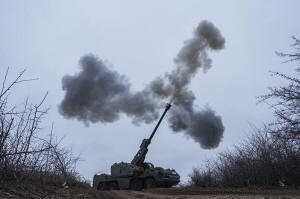Europe considers sending troops to Ukraine if there's a ceasefire. But
would Russia accept?
 Send a link to a friend
Send a link to a friend
 [January 25, 2025]
By SAMYA KULLAB and EMMA BURROWS [January 25, 2025]
By SAMYA KULLAB and EMMA BURROWS
With Russia wearing down Ukraine’s stretched forces and new U.S.
President Donald Trump pressuring the two sides to end their nearly
3-year-old war, Kyiv and some of its European allies are discussing how
that might be achieved in a way that would guarantee Ukraine’s future
security.
Several ideas have been floated in the past, but the one currently
gaining currency would station thousands of European troops in Ukraine,
though not under a NATO banner, to serve as a deterrent and rapid
reaction force should Russia invade again — an apparent non-starter for
Moscow.
Kyiv has signaled a willingness to consider ceasefire terms, but
Ukrainian President Volodymyr Zelenskyy has said security promises from
Kyiv’s allies would be key to a just peace and that without them, it
would only be a matter of time before Russia invaded again. Ukrainian
officials say past agreements with the Kremlin were worthless, pointing
to 2014 and 2015 pacts Russia signed after illegally annexing Crimea but
then broke with its 2022 invasion.
It remains to be seen whether Russia would want to end the war while its
forces appear to be on the front foot, even if they're sustaining heavy
losses, or what terms the Kremlin might seek. But the rest of Europe is
coming to terms with what a Ukrainian defeat would mean for its
security.
“This isn’t just about Ukraine’s sovereignty. Because if Russia succeeds
in this aggression, it will impact all of us for a very, very long
time," U.K. Prime Minister Keir Starmer said during a recent visit to
Kyiv.

What ceasefire plans have been discussed?
With Trump’s return to the White House and his threats to withdraw
crucial U.S. support from Kyiv unless Europe bears more of the Ukraine
burden, some European leaders have pledged their resolve. French
President Emmanuel Macron said building security guarantees for Ukraine
is a key responsibility for European nations, while Starmer said the
U.K. would play a “full part” in any peacekeeping efforts.
Ukraine considers NATO to be the most robust deterrent to Russia, but
Trump and some top European leaders have poured cold water on the idea
of a NATO-led peacekeeping presence in Ukraine.
Among the ideas that apparently haven't gained traction was one in which
allies would invest massively to arm Ukraine to the hilt to deter a
future Russian assault. It would almost surely require major American
support that might not be forthcoming under Trump.
Another idea, suggested by Ukrainians, would have Ukraine's allies
defend it from large-scale Russian air attacks, similar to how the U.S.
helped defend Israel from an Iranian drone attack last year. Experts say
one possible downside to this approach would be that it would expose
sophisticated Western defense technology to Russian military learning.
A third idea, which is getting attention, is one Macron floated nearly a
year ago and is modeled on the Korean armistice. It envisages Western
troops being stationed in Ukraine as a deterrent and rapid reaction
force.
Zelenskyy said there would need to be enough allied troops stationed in
Ukraine to overcome Russia’s manpower advantage.
Furthermore, he said, Kyiv would need sufficient flows of weapons,
including long-range capabilities able to strike Moscow’s defense
industrial complex, including some that are more than 1,000 kilometers
(620 miles) deep inside Russian territory. Trump opposes the idea.
Although Trump is pushing Zelenskyy and Russian President Vladimir Putin
to “make a deal,” European leaders are grappling with questions over how
much military and financial support they could theoretically offer, and
the amount of political risk they would be prepared to take domestically
if they were to send troops to Ukraine and possibly put them in harm's
way.
Allied troops in Ukraine?
The discussions could be for naught. Russia views Ukraine as part of its
geopolitical backyard, not the West's. Putin believes he's winning the
war and can outlast Kyiv, and he won't stomach a proposal that would put
Western troops in Ukraine, current and former senior European and
Russian officials told The Associated Press.
[to top of second column]
|

A Ukrainian brigade fires a self-propelled howitzer toward Russian
front-line positions in the Donetsk region of eastern Ukraine on
Thursday, Jan. 23, 2025. (AP Photo/Evgeniy Maloletka)

“Putin would never say yes to this,” and European nations would be
unlikely to go ahead if Putin makes it clear it's a red line, said
Boris Bondarev, a former Russian diplomat who quit his role in
protest after the war started.
Maria Zakharova, Russia's Foreign Ministry spokesperson, said
Thursday that NATO troops in Ukraine would be “categorically
unacceptable” and provoke “uncontrolled escalation."
Nevertheless, an advisor to the Ukrainian government said “technical
discussions” with allies are ongoing and speculated that Moscow
might accept such scenario depending on what concessions Ukraine is
willing to make. The official spoke to the AP on the condition of
anonymity to speak freely about sensitive matters.
Zelenskyy indicated this week that he wants foreign support and that
Ukraine would need tens of thousands of allied troops at a minimum.
If European nations were to agree to send troops to Ukraine, it
would send a strong signal to Russia that Europe intends to have
skin in the game, said Camille Grand, a former NATO official now
with the European Council on Foreign Relations.
But even if European nations were to agree, there are questions
around Europe’s military production capacity, manpower and ability
to fill a potential vacuum if there's an expected reduction in U.S.
aid under Trump. The U.S. provides Kyiv with 40% of its military
support.
Europe’s defense production is fragmented along national lines and
is underfunded, and there are questions around national governments’
ability to defend their own people, let alone meet Ukraine’s
enormous needs.
Peacekeepers or a tripwire?
There are many aspects of the Macron proposal that would need to be
ironed out, including where in Ukraine allied forces would be
deployed, which countries would send troops and what capabilities
they would have “because that would also be a signal of their
ability to fight,” said Marie Dumoulin, program director for Wider
Europe at the European Council on Foreign Relations.
In conversations with the AP, Ukrainian officials described such
allied troops as serving as a peacekeeping mission but also as a
tripwire force, in which they would be committed to counterattacking
in the event of a Russian assault.
“There are misrepresentations when people describe this as potential
peacekeeping,” said Dumoulin. A senior Ukrainian official and two
Western official both concurred. The officials spoke on condition of
anonymity to speak freely about sensitive talks.

A traditional peacekeeping mission requires a UN vote, one that
Russia can easily veto. It would also not include a guarantee to
counterattack in the event of a Russian strike — a key component of
the type of security guarantee Kyiv is seeking.
Though the initiative would occur outside of the NATO format, one
Western official pointed to NATO’s multinational battalions in the
Baltic countries — which, unlike Ukraine, are members of the
alliance — as a possible model. Others have also alluded to
stabilization forces in Bosnia as an example.
The Ukrainian president said he discussed the French proposal for
foreign contingents with the U.K., France, Poland and the Baltic
states, but the reality is, it would meet fierce resistance from
Putin. Even so, opening negotiations with a proposal for a Western
troop presence in Ukraine could leave European nations with
negotiating room to maneuver with Putin, who would see such a
suggestion "as NATO in Ukraine anyway,” Dumoulin said.
All contents © copyright 2025 Associated Press. All rights reserved
 |